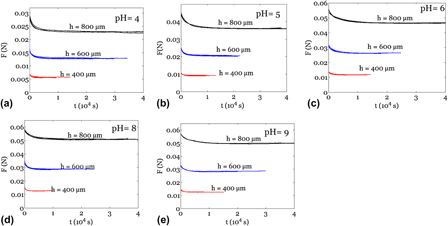Crossref Citations
This article has been cited by the following publications. This list is generated based on data provided by
Crossref.
Chester, Shawn A.
2012.
A constitutive model for coupled fluid permeation and large viscoelastic deformation in polymeric gels.
Soft Matter,
Vol. 8,
Issue. 31,
p.
8223.
Zhang, Yan
Liu, Zishun
Swaddiwudhipong, Somsak
Miao, Haiyan
Ding, Zhiwei
and
Yang, Zhengzhi
2012.
pH-Sensitive Hydrogel for Micro-Fluidic Valve.
Journal of Functional Biomaterials,
Vol. 3,
Issue. 3,
p.
464.
Jeon, Oju
and
Alsberg, Eben
2013.
Regulation of Stem Cell Fate in a Three‐Dimensional Micropatterned Dual‐Crosslinked Hydrogel System.
Advanced Functional Materials,
Vol. 23,
Issue. 38,
p.
4765.
Drira, Zouheir
and
Yadavalli, Vamsi K.
2013.
Nanomechanical measurements of polyethylene glycol hydrogels using atomic force microscopy.
Journal of the Mechanical Behavior of Biomedical Materials,
Vol. 18,
Issue. ,
p.
20.
Andrews, James W.
Bowen, James
and
Cheneler, David
2013.
Optimised determination of viscoelastic properties using compliant measurement systems.
Soft Matter,
Vol. 9,
Issue. 23,
p.
5581.
Chiang, Chung-yi
Huang, Lei
and
Ghatlia, Naresh
2013.
Polymers for Personal Care and Cosmetics.
Vol. 1148,
Issue. ,
p.
175.
Gao, Xin
and
Gu, Weiyong
2014.
A new constitutive model for hydration-dependent mechanical properties in biological soft tissues and hydrogels.
Journal of Biomechanics,
Vol. 47,
Issue. 12,
p.
3196.
Wang, Qi-Ming
Mohan, Anirudh C.
Oyen, Michelle L.
and
Zhao, Xuan-He
2014.
Separating viscoelasticity and poroelasticity of gels with different length and time scales.
Acta Mechanica Sinica,
Vol. 30,
Issue. 1,
p.
20.
An, Zengyong
Xu, Minglong
Feng, Bo
Zhang, Feng
and
He, Xiang
2014.
Novel hybrid piezo-electromagnetic actuator for micro-indentation loading.
Smart Materials and Structures,
Vol. 23,
Issue. 12,
p.
125025.
Chen, Yi
Xu, Weijian
Liu, Wenyong
and
Zeng, Guangsheng
2015.
Responsiveness, swelling, and mechanical properties of PNIPA nanocomposite hydrogels reinforced by nanocellulose.
Journal of Materials Research,
Vol. 30,
Issue. 11,
p.
1797.
Bae, Jinhye
Ouchi, Tetsu
and
Hayward, Ryan C.
2015.
Measuring the Elastic Modulus of Thin Polymer Sheets by Elastocapillary Bending.
ACS Applied Materials & Interfaces,
Vol. 7,
Issue. 27,
p.
14734.
Axpe, Eneko
Bugnicourt, Loic
Merida, David
Goiriena-Goikoetxea, Maite
Unzueta, Iraultza
Sanchez-Eugenia, Ruben
Garcia, Jose Angel
Plazaola, Fernando
and
Contera, Sonia
2015.
Sub-nanoscale free volume and local elastic modulus of chitosan–carbon nanotube biomimetic nanocomposite scaffold-materials.
Journal of Materials Chemistry B,
Vol. 3,
Issue. 16,
p.
3169.
Guglielmi, P.O.
Herbert, E.G.
Tartivel, L.
Behl, M.
Lendlein, A.
Huber, N.
and
Lilleodden, E.T.
2015.
Mechanical characterization of oligo(ethylene glycol)-based hydrogels by dynamic nanoindentation experiments.
Journal of the Mechanical Behavior of Biomedical Materials,
Vol. 46,
Issue. ,
p.
1.
Bouklas, Nikolaos
Landis, Chad M.
and
Huang, Rui
2015.
A nonlinear, transient finite element method for coupled solvent diffusion and large deformation of hydrogels.
Journal of the Mechanics and Physics of Solids,
Vol. 79,
Issue. ,
p.
21.
Venditto, Vincenzo
Pellegrino, Marina
Califano, Rosa
Guerra, Gaetano
Daniel, Christophe
Ambrosio, Luigi
and
Borriello, Anna
2015.
Monolithic Polymeric Aerogels with VOCs Sorbent Nanoporous Crystalline and Water Sorbent Amorphous Phases.
ACS Applied Materials & Interfaces,
Vol. 7,
Issue. 2,
p.
1318.
Bush, Brian G.
Shapiro, Jenna M.
DelRio, Frank W.
Cook, Robert F.
and
Oyen, Michelle L.
2015.
Mechanical measurements of heterogeneity and length scale effects in PEG-based hydrogels.
Soft Matter,
Vol. 11,
Issue. 36,
p.
7191.
Gerges, I.
Tamplenizza, M.
Lopa, S.
Recordati, C.
Martello, F.
Tocchio, A.
Ricotti, L.
Arrigoni, C.
Milani, P.
Moretti, M.
and
Lenardi, C.
2016.
Creep-resistant dextran-based polyurethane foam as a candidate scaffold for bone tissue engineering: Synthesis, chemico-physical characterization, and in vitro and in vivo biocompatibility.
International Journal of Polymeric Materials and Polymeric Biomaterials,
Vol. 65,
Issue. 14,
p.
729.
Hu, Wei
Corbera-Sabaté, Carlos
Chen, Xiao Dong
and
Mercadé-Prieto, Ruben
2017.
Poroviscoelasticity of whey protein hydrogels at different length and time scales.
Food Hydrocolloids,
Vol. 72,
Issue. ,
p.
237.
Nogning Kamta, P.
Chicot, D.
Roudet, F.
Touzin, M.
Louis, G.
Chicot, Didier
Iost, Alain
Montagne, Alex
and
Le Bourhis, Eric
2017.
Fluage et relaxation par indentation d’aciers au chrome.
Matériaux & Techniques,
Vol. 105,
Issue. 1,
p.
103.
Zheng, Yue
Crosby, Alfred J.
and
Cai, Shengqiang
2017.
Indentation of a stretched elastomer.
Journal of the Mechanics and Physics of Solids,
Vol. 107,
Issue. ,
p.
145.





